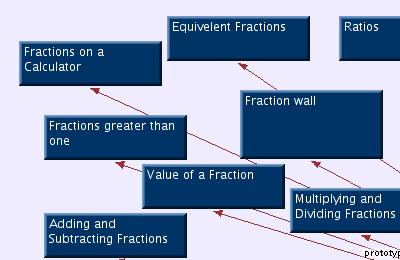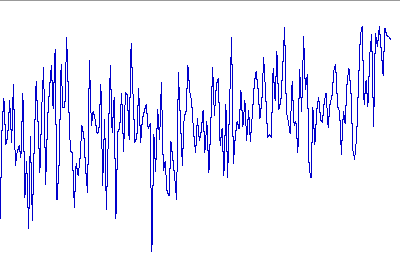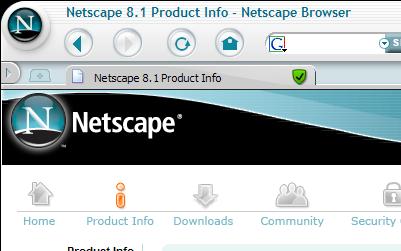March 14th, 2006

Imagine covering a wall in a classroom with 154 sticky notes each labelled with a different topic in GCSE Maths, and encouraging students (or colleagues) to move the notes around, suggest links between the topics, argue for collapsing topics into each other or splitting others into several different topics. The sticky notes have colour coding according to module (Number, Algebra, Shape, Data) but related topics from different modules can easily be put close together. Collections of related topics can be surrounded by different coloured tape, and links between topics can be shown using string. The result would be a wicked classroom display, but would require a lot of effort, and considerable supplies of sticky notes, and would probably suffer damage fairly soon. The benefits would include finding links between topics in different modules, arguing over the topics and their relations with other topics, and generally being able to ‘see the wood for the trees’.
Software exists that can mimic sticky notes on the screen and allow you to challenge students to find the links between the topics and to define and defend groupings of topics. Inspiration (Mac OS, Windows, and PDAs) and Tinderbox (Mac OS at present, Windows version in development) are two packages that could enable you to produce such a mother of all topic maps. My preference is for Tinderbox for this project as the ‘sticky notes’ are actually documents that can contain arbitrary quantities of text and (bitmapped) images. Any notes you make to the map can be exported as a set of automatically hyperlinked Web pages, and the export can be controlled in great detail by the use of a template. A new version of Inspiration has just been released with improved HTML export of outlines and charts – the package is firmly based around the idea of an outline document and the ability to switch rapidly between the topic map and an outline document.
Posted in ILT, Maths | Comments Off
March 13th, 2006
According to the BBC News quoting research by doctors in London and Shrewsbury, there may be a link between migraine with aura and a hole in the heart. Their figures (quoted from the BBC article) are as follows…
“The latest study screened 432 migraine with aura patients, and found 24% had a moderate [or] large PFO - six times greater than the number found in the general population.”
I make that around 104 with a ‘hole in the heart’ from the screened sample compared with 17 from a similar sized sample of the rest of us. The good news is that a correction of the hole in the heart reduces the severity of the migraine in many cases. The doctors used an interesting measure of improvement: severity of headache multiplied by length.
Posted in Maths, Notes | Comments Off
March 13th, 2006

Notice any trend? Upwards? Downwards? Part of a sine wave of longish period? Scribble an idea now, then compare with the full series.
The chart above (shown without axes on purpose) is a plot of the yearly mean temperature from 1800 to 2005 taken from the Central England Temperature series. The series extends from 1659, as reconstructed by Professor Gordon Manley. Some links…
Handy for those moving averages….
Posted in Maths | Comments Off
March 13th, 2006
Metropolitan Police officers have apparently received ‘guidance’ about blogging that includes the following phrase; “consider the impact of expressing views and opinions that…bring the organisation into disrepute”.
What is, exactly, a blog? Perhaps an online notebook where you list links, tips, ideas, common experience (like the blog you are now reading) or sometimes a place where you blow off a bit of steam after a frustrating day. We all have frustrating days, but steam is perhaps best let off in the smoke free bar over an orange juice.
Blanket ‘guidance’ on blogging may discourage people with plenty to say of value to other practitioners – I’d like to see a little more precision in this sort of ‘guidance’.
Posted in Notes | Comments Off
March 8th, 2006

The Netscape Web browser is still out there at version 8 and sports a built in adware and spyware scanner, a choice of rendering engines (Firefox or MS Internet Explorer) with tabbed browsing and a range of security settings – many on a per site basis. Windows only – no Mac OS X or Linux build, but will work on Windows 98 SE upwards.
There are skins available to suit the most arcane tastes (if you spend a long time in front of a computer you may as well make it look reasonable) and the software can co-exist with Firefox, MS Internet Explorer and Opera. Netscape is just a browser with no mail client or Web editing function, like Firefox.
Those (of us) who prefer an integrated internet application suite can download Mozilla which has now frozen development at version 1.7x or the continuation of Mozilla called SeaMonkey , currently at 1.0 corresponding to Mozilla 1.8. Both of these releases contain a Web browser, chat client, mail and news applications and a Web page editor.
Posted in ILT | Comments Off
March 4th, 2006

Crate in shop window in Warsaw, Poland. Margarine?
Posted in Photos | Comments Off
March 4th, 2006
I once heard the Beaufort Scale rendered as epic poetry. The reader started in a quiet conversational tone, speaking fairly quickly. As he ascended the scale, the voice grew louder and the pace slowed. The word ‘HURRICANE’ was bellowed at considerable volume.
The table below was copied from a notebook entry made one foul day in Whitby, and is placed here in honour of the Mersey Ferry – the Liverpool floating stage has sunk owing to unusually low tides and bad weather. I can remember a storm in the late 70s that sunk a newly constructed landing stage on the Liverpool side. At the time reports suggested that the heavy concrete structure retained by hinged booms had a resonant frequency close to the swell encountered in the storm.
| Scale | Knots | Description |
| 0 | Calm
Under 1 | Smooth glassy sea |
| 1 | Light
2 | Small scale-like ripples without crests |
| 2 | Light
5 | Small waves, still short and smooth but more pronounced |
| 3 | Light
8 | Whitecaps forming but still mostly smooth. Occasional white foam appearing |
| 4 | Moderate
13 | Waves still small but longer whitecaps fairly general |
| 5 | Fresh
18 | Moderate sized waves now long and more pronounced. Whitecaps everywhere, occasional foaming spray |
| 6 | Strong
24 | Formation of larger waves. Crests break and leave areas of white foam, some spray |
| 7 | Strong
30 | Sea heaps up. Long streaks of foam begin to form along wind direction. More spray (difficulty walking against wind) |
| 8 | Gale
37 | Large waves with very long crests, spray blown off wave crests. Long thick streaks of foam (walking progress considerably impeded) |
| 9 | Severe gale
44 | Mountainous seas. Dens streaks of foam along direction of wind. Wave crests begin to topple and roll over. Spray may affect visibility |
| 10 | Storm
52 | Towering, tumbling waves with long overhanging crests. Sea white with foam. Visibility restricted by spray |
| 11 | Violent storm
60 | Extremely mountainous sea, white and foaming. Drastically reduced visibility |
| 12 | Hurricane
68+ | Air filled with driving foam and spray as wave crests are torn off by wind. Sea completely white and frothy. Visibility very difficult |
Posted in Maths, Notes | Comments Off



